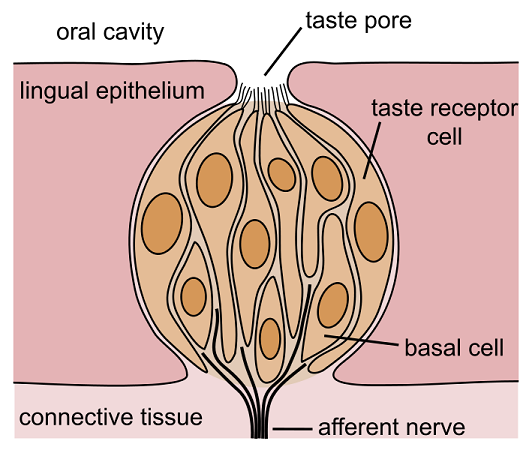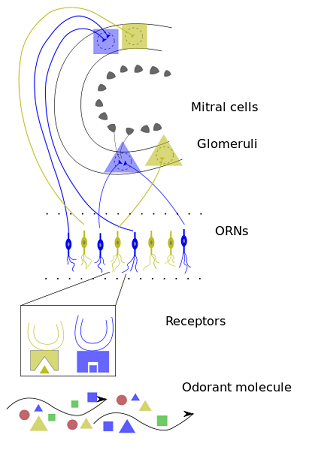
Gustation and olfaction are taste and smell senses respectively.
Gustation
The human gustatory system allows us to interpret chemical compounds of substances we ingest into tastes.
The tongue has very limited types of taste receptors. There are five main types: bitter, sweet, salty, sour, and recently discovered umami (savory).¹ These taste receptor cells are found in the taste buds located over the surface of the tongue. Taste buds are small organs that contain a number of gustatory receptor cells. Different people have different densities of taste buds and therefore a different number of taste receptor cells.
When taste receptor cells capture taste information, they send it along a variety of cranial nerves from the tongue and mouth to the brainstem and thalamus. From the thalamus, it goes to the primary gustatory cortex in the brain where it is interpreted.
A taste bud.²
 Olfaction
Olfaction
The human olfactory system allows us to interpret smells in the environment.The olfactory mucosa is the mucous membrane lining the top of the nasal sinuses that contains the olfactory receptors. It projects axons into the olfactory bulbs, which are stalk-like structures located on the underside of the frontal loads. They contain the neural circuits that perform the first analysis of olfactory information. This information travels from the bulbs, along the olfactory nerve and directly to the underside the frontal cortex, where the primary olfactory cortex lies.¹
Other chemical senses travel to the thalamus and are ‘sorted’ before being sent to their respective primary cortices. The olfactory senses travel straight to the primary cortex, located in the limbic system that is responsible for emotional memory. This means that before someone even knows they are smelling something, or what it is, they have emotionally learned this. This is why smells often bring up strong emotional memories that remind people of times, places and people.
The gustatory and olfactory systems show a loss of sensitivity due to sensory adaptation. Sensory adaptation results in a change, usually a decrease, in sensitivity to a stimulus when a sensory system has been repeatedly stimulated. They also show a tendency to habituation. This is when an organism ceases to respond to a stimulus which is no longer biologically relevant.
A schematic of the early olfactory system.³
References:
1. Psychology: the Science of Behaviour - Neil R. Carlson.
2. Image Credit: Wikimedia Commons
3. Image Credit: Wikimedia Commons
